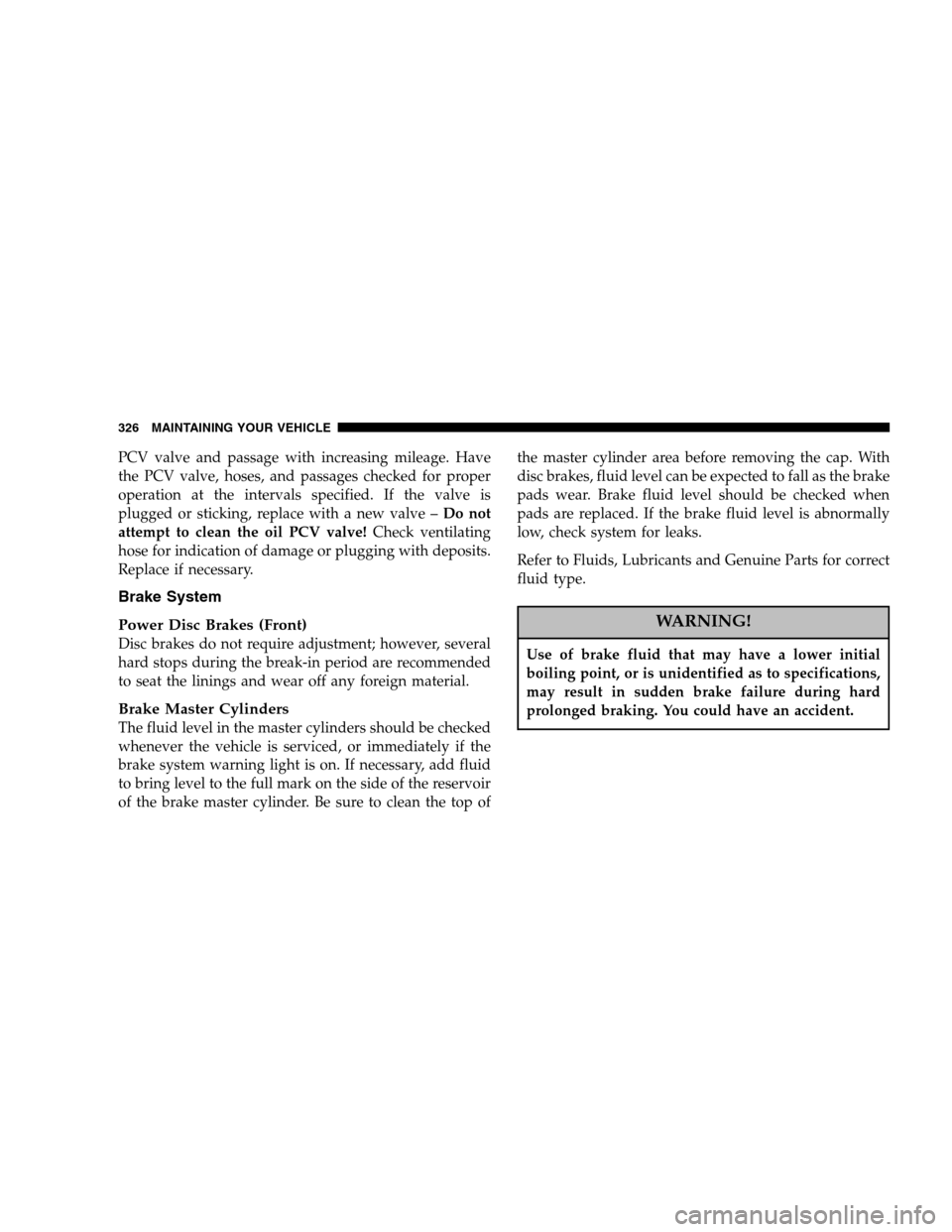Page 305 of 408

cap until a�clicking�sound is heard. This is an indication
that the gas cap is properly tightened. Press the odometer
reset button to turn the message off. If the problem
persists, the message will appear the next time the
vehicle is started. This might indicate a damaged cap. If
the problem is detected twice in a row, the system will
turn on the Malfunction Indicator Light (MIL). Resolving
the problem will turn the MIL light off.
EMISSIONS INSPECTION AND MAINTENANCE
PROGRAMS
In some localities, it may be a legal requirement to pass
an inspection of your vehicle’s emissions control system.
Failure to pass could prevent vehicle registration.
For states which have an I/M (Inspection and
Maintenance) requirement, this check verifies the
following: the MIL (Malfunction Indicator Lamp) is functioning and is not on when the engine is running,
and that the OBD (On Board Diagnostic) system is ready
for testing.
Normally, the OBD system will be ready. The OBD
system may
notbe ready if your vehicle was recently
serviced, if you recently had a dead battery, or a battery
replacement. If the OBD system is determined not ready
for the I/M test, your vehicle may fail the test.
Your vehicle has a simple ignition key actuated test
which you can use prior to going to the test station. To
check if your vehicle’s OBD system is ready, you must do
the following:
1. Insert your ignition key into the ignition switch.
2. Turn the ignition to the ON position, but do not crank
or start the engine. If you crank or start the engine, you
will have to start this test over.
MAINTAINING YOUR VEHICLE 305
7
Page 306 of 408

3. As soon as you turn your key to the ON position, you
will see your MIL symbol come on as part of a normal
bulb check.
4. Approximately 15 seconds later, one of two things will
happen: a. The MIL light will blink for approximately 5 sec-
onds and then remain on until the first engine crank or
the key is turned off. This means that your vehicle’s
OBD system is not readyand you should notproceed
to the I/M station.
b. The MIL light will remain fully illuminated until the
first engine crank or the key is turned off. This means
that your vehicle’s OBD system is readyand you can
proceed to the I/M station.
If your OBD system is not readyyou should see your
dealer or repair facility. If your vehicle was recently
serviced or had a battery failure or replacement, you may need to do nothing more than drive your vehicle as you
normally would in order for your OBD system to update.
A recheck with the above test routine may then indicate
that the system is now ready.
Regardless of whether your vehicle’s OBD system is
ready or not ready, if the MIL symbol is illuminated
during normal vehicle operation, you should have your
vehicle serviced before going to the I/M station. The I/M
station can fail your vehicle because the MIL symbol is on
with the engine running.
REPLACEMENT PARTS
Use of genuine Mopar
�parts for normal/scheduled
maintenance and repairs is highly recommended to in-
sure the designed performance. Damage or failures
caused by the use of non-Mopar �parts for maintenance
and repairs will not be covered by the manufacturer’s
warranty.
306 MAINTAINING YOUR VEHICLE
Page 326 of 408

PCV valve and passage with increasing mileage. Have
the PCV valve, hoses, and passages checked for proper
operation at the intervals specified. If the valve is
plugged or sticking, replace with a new valve – Do not
attempt to clean the oil PCV valve! Check ventilating
hose for indication of damage or plugging with deposits.
Replace if necessary.
Brake System
Power Disc Brakes (Front)
Disc brakes do not require adjustment; however, several
hard stops during the break-in period are recommended
to seat the linings and wear off any foreign material.
Brake Master Cylinders
The fluid level in the master cylinders should be checked
whenever the vehicle is serviced, or immediately if the
brake system warning light is on. If necessary, add fluid
to bring level to the full mark on the side of the reservoir
of the brake master cylinder. Be sure to clean the top of the master cylinder area before removing the cap. With
disc brakes, fluid level can be expected to fall as the brake
pads wear. Brake fluid level should be checked when
pads are replaced. If the brake fluid level is abnormally
low, check system for leaks.
Refer to Fluids, Lubricants and Genuine Parts for correct
fluid type.
WARNING!
Use of brake fluid that may have a lower initial
boiling point, or is unidentified as to specifications,
may result in sudden brake failure during hard
prolonged braking. You could have an accident.
326 MAINTAINING YOUR VEHICLE
Page 330 of 408

dipstick cap is properly reseated. It is normal for the
dipstick cap to spring back slightly from its fully seated
position, as long as its seal remains engaged in the
dipstick tube.
Automatic Transmission Fluid And Filter Change
To obtain best performance and long life for automatic
transmissions, the manufacturer recommends that they
be given regular maintenance service by an Authorized
Dodge Dealer or Service Center. It is important that the
transmission fluid be maintained at the correct level and
that it be drained and refilled as specified.
Follow the proper Maintenance Schedule for your type of
driving.
It is important that proper lubricant is used in the
transmission. Refer to Fluids, Lubricants and Genuine
Parts for correct fluid type. It is important that the
transmission fluid be maintained at the prescribed level
using the recommended fluid.
CAUTION!
Using a transmission fluid other than the manufac-
turers recommended fluid may cause deterioration
in transmission shift quality and/or torque converter
shudder. Using a transmission fluid other than the
manufacturers recommended fluid will result in
more frequent fluid and filter changes. Refer to
Fluids, Lubricants and Genuine Parts for correct
fluid type.
Special Additives
The manufacturer strongly recommends against the ad-
dition of any additives to the transmission. Exception to
this policy is the use of special dyes to aid in detecting
fluid leaks. The use of transmission sealers should be
avoided, since they may adversely affect seals.
330 MAINTAINING YOUR VEHICLE
Page 338 of 408
Cavity Cartridge
Fuse Mini Fuse Description
9 10 Amp Red Airbag System #3
10 Spare
11 10 Amp Red AC Clutch
12 15 Amp Blue T Tow Lt Stop/Turn
13 15 Amp Blue T Tow Rt Stop/Turn
14 20 Amp Yellow IOD #2
15
25 Amp NaturalTrans/PCM
16 20 Amp Yellow Horn
17 20 Amp Yellow ABS Feed (Valves)
18 20 Amp Yellow Fuel Pump
19 15 Amp Blue Stop Lamp (CHMSL)
20 20 Amp Yellow CCN Door Locks/BTSI
Cavity Cartridge
Fuse Mini Fuse Description
21 25 Amp Natu- ral Audio Amp
22 20 Amp Yellow Power Outlet (Switchable)
23 20 Amp Yellow Fog Lamps
24 20 Amp Yellow PCM B+
25 15 Amp Blue CCN Illumina- tion
26 Spare
27 10 Amp Red Power Mirror
28 20 AmpYellow Power Outlet
29 20 Amp Yellow FCM4 (Wip- ers)
30 Spare
31 Spare
32 30 Amp Pink FCM1 (Ext. Lights # 1)
338 MAINTAINING YOUR VEHICLE
Page 339 of 408
Cavity Cartridge
Fuse Mini Fuse Description
33 30 Amp Pink ASD
34 30 Amp Pink FCM2 (Ext. Light # 2)
35 40 Amp Green HVAC Blower Motor
36 10 Amp Red Ignition UNLK/
RN/ST
37 10 Amp Red Crank
38 20 Amp Blue Run/Start
39 30 Amp Pink Starter Sole- noid
40 Spare
41 30 Amp Pink Wiper Motor
42 25 Amp Natu- ral FCM5 (T-Case)
43 10 Amp Red Lt Park Lamps
44 10 Amp Red Rt Park LampsCavity Cartridge
Fuse Mini Fuse Description
45 20 Amp Yellow T Tow Park Lamps
46 10 Amp Red Airbag System #2
47 40 Amp Green Ignition Run/ Acc
48 20 Amp Blue Sunroof/ Sound Box
49 30 Amp Pink T Tow B+
50 40 Amp Green ABS Module (Pump)
51 40 Amp Green Park Lamps
52 Spare
53 40 Amp Green Rear Defogger
54 Spare
55 10 Amp Red CCN ACC Feed
56 10 Amp Red Heated Seats
MAINTAINING YOUR VEHICLE 339
7
Page 341 of 408

I.O.D. cavity includes a snap-in retainer that allows the
fuse to be disconnected, without removing it from the
fuse block.
•The transfer case should be placed in the 4HI mode
and kept in this position to minimize the battery drain.
•As an alternative to the above steps you may discon-
nect the negative cable from the battery.
REPLACEMENT LIGHT BULBS
LIGHT BULBS — Interior Bulb No.
Dome Light ........................ WL212–2
Cargo Light ............................ 567
Overhead Console Lights ................... 192
Reading Light ....................... WL212–2 LIGHT BULBS — Outside Bulb No.
Headlight
............................. H13
Front Park/Turn/Sidemarker .............3157NA
Back-Up .............................. 3157
Center High Mounted Stoplight .............. 921
Fog Lamp ............................. 9145
Rear Sidemarker ......................... 168
License Plate Light ....................... 168
Rear Tail, Stop, Turn Signal .................3057
MAINTAINING YOUR VEHICLE 341
7
Page 363 of 408
Once a Month
•Check tire pressure and look for unusual wear or
damage.
•Inspect the battery and clean and tighten the terminals
as required.
•Check the fluid levels of coolant reservoir, brake
master cylinder, and transmission and add as needed.
•Check all lights and all other electrical items for correct
operation. At Each Oil Change
•Change the engine oil filter.
•Inspect the exhaust system.
•Inspect the brake hoses.
•Inspect the CV joints (if equipped) and front suspen-
sion components.
•Check the automatic transmission fluid level (if
equipped).
•Check the manual transmission fluid level (if
equipped).
•Check the coolant level, hoses, and clamps.
MAINTENANCE SCHEDULES 363
8
M
A I
N T
E
N A
N C E
S
C
H E
D
U L
E
S